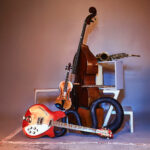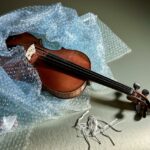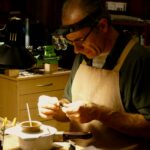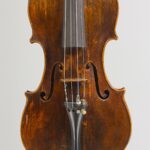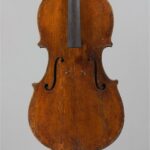Samedi 27 juin se tenait à Vichy Enchères notre vente de vents et de cordes pincées. Comme il est d’usage avant nos ventes d’instruments, les experts reconnus dans chacune des spécialités en question se sont réunis dans nos locaux pour un examen de visu des instruments. Une fois n’est pas coutume, ces expertises ont apporté leur lot de surprises… Parmi lesquelles, une guitare romantique restée anonyme jusque-là. Cette dernière a tout de suite retenu l’attention des experts Jérôme Casanova, Daniel Sinier et Françoise de Ridder.
La qualité d’exécution et la belle facture de cette guitare avaient déjà fait l’objet d’une étude menée par le guitariste et collectionneur Bruno Marlat (publiée dans le magazine Guitare Classique N°71) en 2015. Pour la première fois, un rigoureux examen de l’instrument avait été réalisé, aboutissant à une proposition d’attribution de la guitare à Guillaume-Louis Martin (1787-1854), un luthier parisien élève de Pons et proche de Lacote. L’étude de Bruno Marlat représente un jalon important dans la redécouverte de cette guitare, puisqu’il a, le premier, réalisé une observation formelle et minutieuse de l’instrument, qui en dégage des détails caractéristiques des guitares romantiques françaises du premier tiers du XIXème siècle. Bruno Marlat a ainsi ouvert la voie à d’autres recherches.
L’attribution d’un objet est toujours le résultat de quêtes, contre-enquêtes, vérifications… Elle est liée à une réalité culturelle, à l’état de la connaissance à un moment donné, à l’évolution des techniques d’analyses matérielles, et en cela, l’attribution a un caractère historique. L’expertise de cette guitare romantique, ce vendredi 26 juin, a confirmé ce principe. En effet, l’examen physique de l’instrument a conduit Jérôme Casanova, expert en cordes pincées, sur la piste d’un autre luthier : Nicolas Grobert (1794-1866). Originaire de Mirecourt, Grobert travaille quelque temps à Paris avant de retourner s’établir dans sa ville natale. On ne lui connaît que peu de guitares et il tient sa célébrité à sa seule signée – aujourd’hui conservée au musée de la Musique de Paris – sur laquelle sont apposés les noms de deux des plus grands virtuoses du XIXème siècle : Paganini et Berlioz.
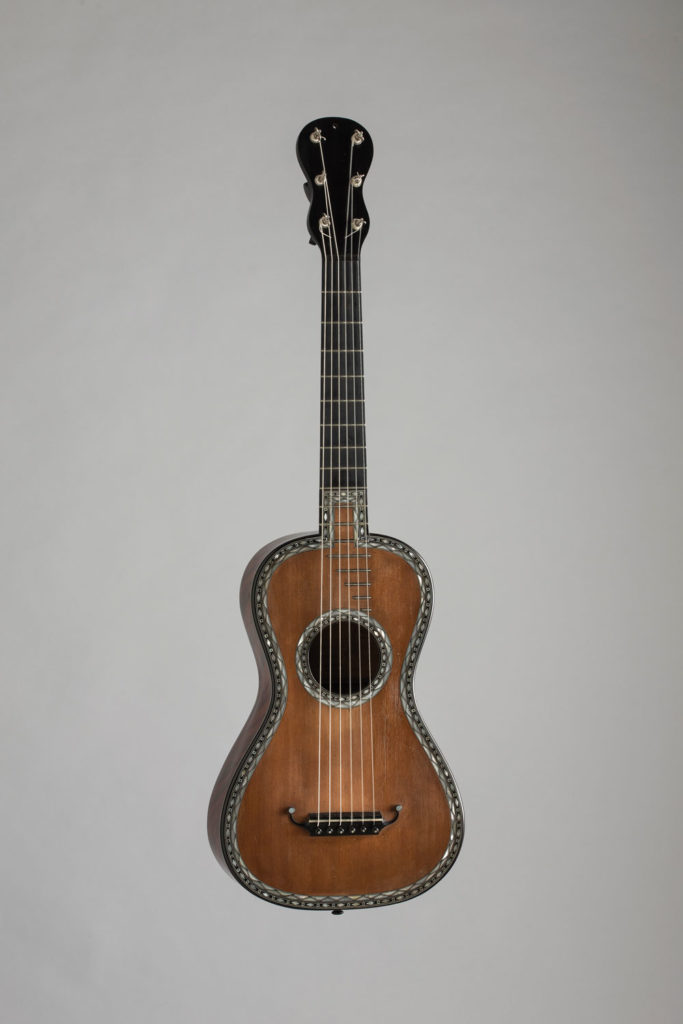
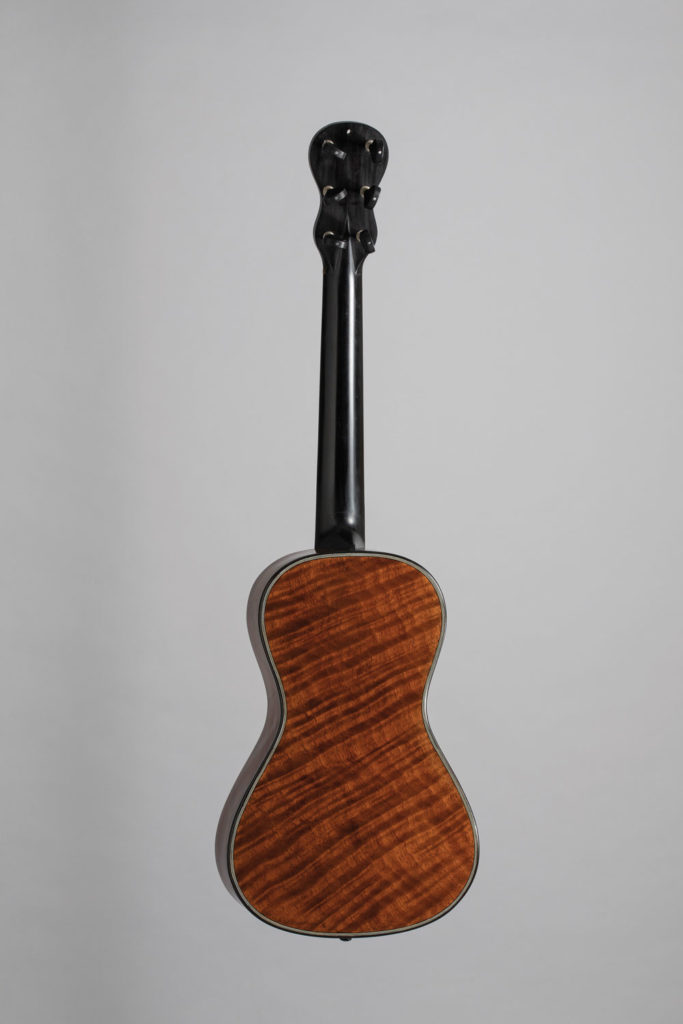
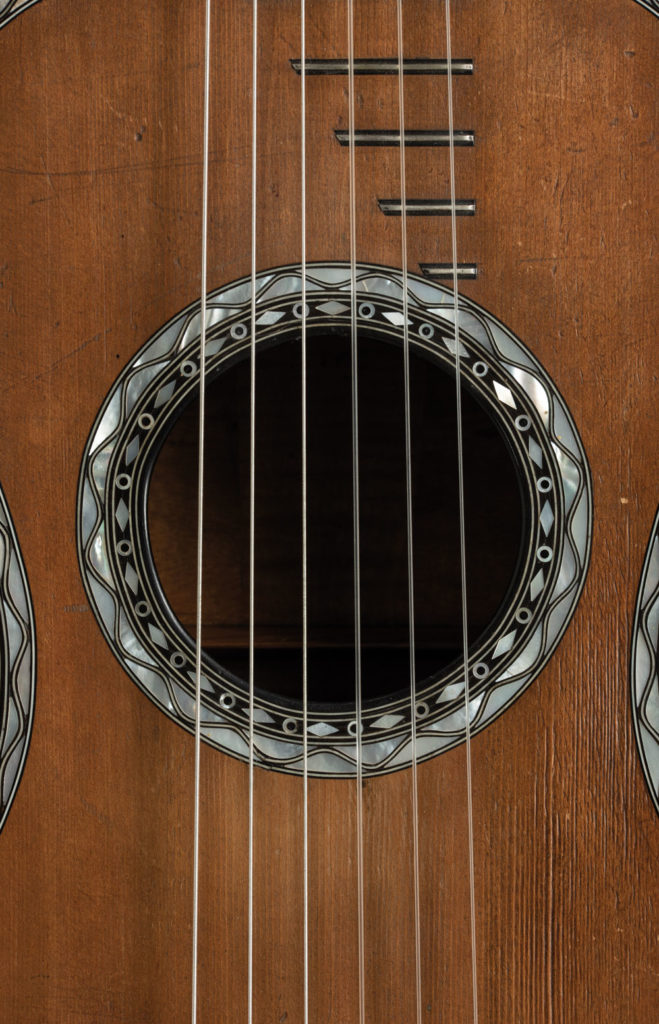
Bien que beaucoup d’éléments soient proches de la facture parisienne, comme l’avait mis en évidence Bruno Marlat, certaines caractéristiques sont propres à Grobert. Comme l’écrivent Françoise de Ridder et Daniel Sinier, “Le barrage de la table est la chose la plus intéressante dans le travail de cet auteur rare et innovant. […] Chaque barre a un emplacement bien précis et a un profil tout à fait particulier que nous avons retrouvé d’une guitare à l’autre.” (Sinier de Ridder, Nicolas Grobert, 2009, article en ligne). On comprend toutefois les premières hypothèses de Marlat, puisque plusieurs détails de la guitare se rapprochent de la facture parisienne d’un Martin ou d’un Lacote. Grobert invente notamment une cheville mécanique, à l’instar des chevilles à papillon de Lacote, et tout comme ce dernier, il place des petites barres verticales pour répondre aux aigus. Toutefois, certaines caractéristiques ne se retrouvent que sur les guitares de Grobert. On pense, entre autres, à la simplification du manche-talon par rapport à ceux des luthiers parisiens, mais surtout au dessin du chevalet, que l’on retrouve sur toutes ses guitares. Autant d’éléments qui ont permis à Jérôme Casanova d’assigner cette guitare à Nicolas Grobert.
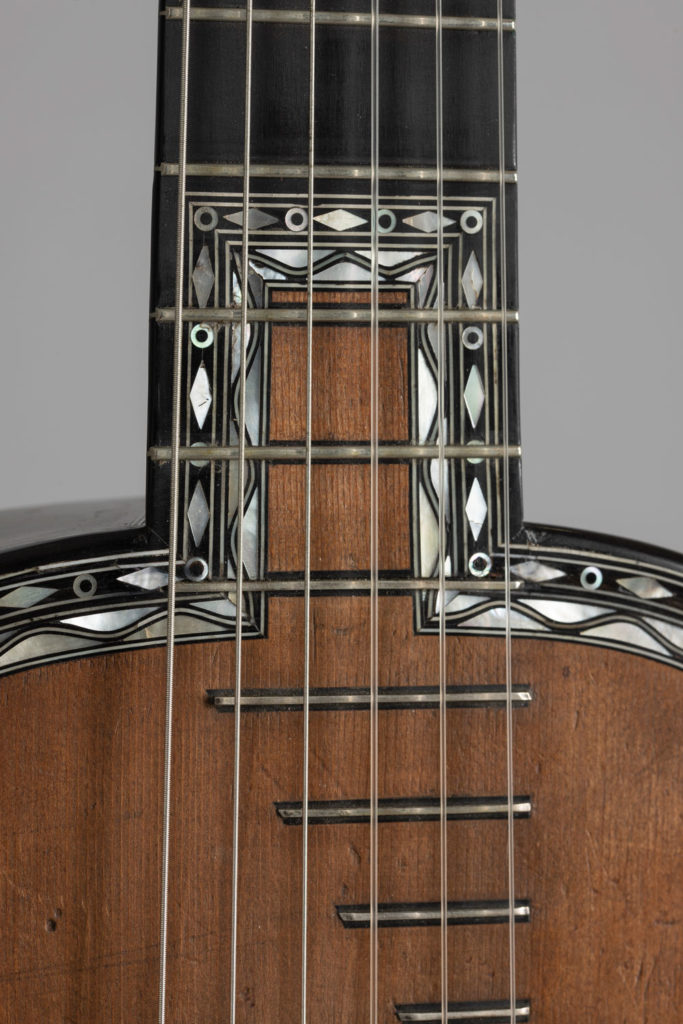
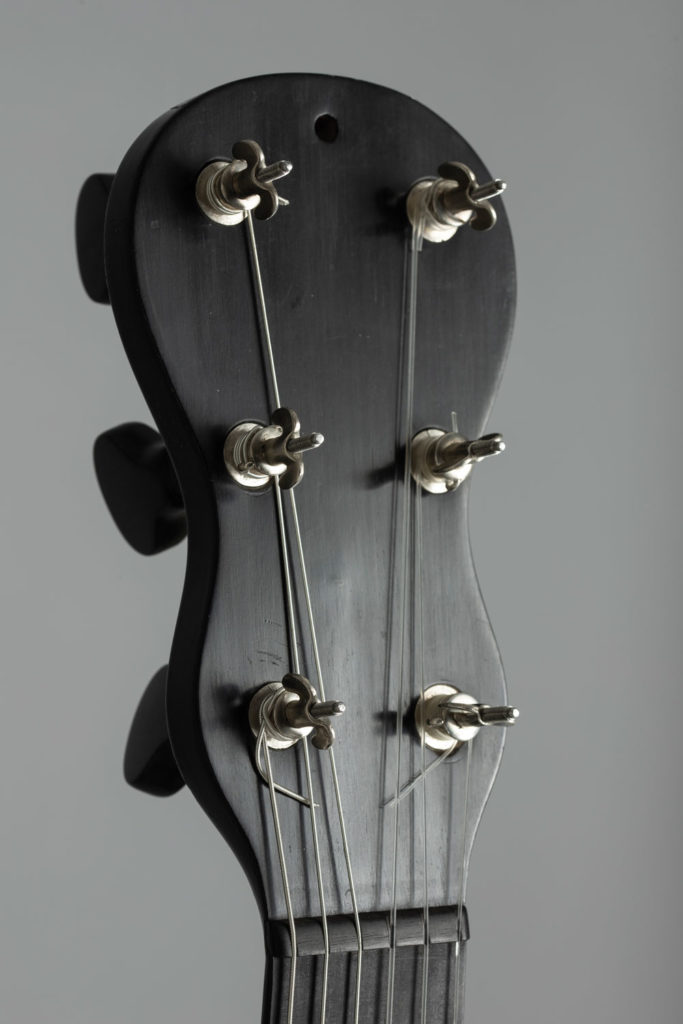
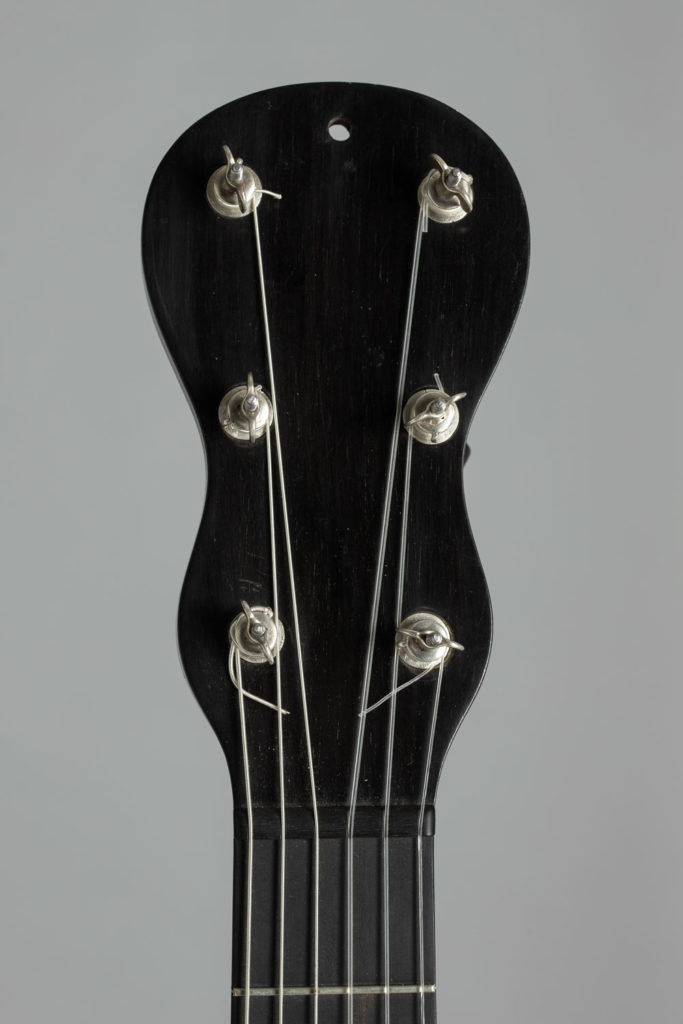
L’expertise, quand elle est réalisée par des professionnels indépendants qui se retrouvent autour d’un même objet, comme cela a été le cas pour la guitare de Grobert, est l’une des manières les plus fiables de garantir la justesse d’une authentification – et également d’une estimation. La communication entre experts est indispensable, tout comme l’examen de visu. Enfin, l’authentification d’une oeuvre repose toujours sur sa recontextualisation historique, nécessitant parfois l’usage d’outils d’analyses matérielles. Au sein de Vichy Enchères, les experts peuvent notamment s’appuyer sur l’endoscope, un appareil permettant de voir à l’intérieur des instruments et, ainsi, de découvrir de nouveaux indices…

N° 140 • Jolie guitare romantique de Nicolas Grobert
Faite à Mirecourt vers 1830.
Cette guitare avait été préalablement attribuée par Bruno Marlat à Guillaume Louis MARTIN, dans son article paru dans Guitare Classique magazine n°71, mais les recherches récentes nous ont permis de confirmer que cet instrument a été fait par Grobert.
Prix avec frais : 10 664 €
<h1><a><div id="english"></div>A NEW GUITAR BY NICOLAS GROBERT DISCOVERED</a></h1>The sale of wind and plucked string instruments took place on Saturday, June 27th at Vichy Enchères. As usual before our sales of instruments, the renowned experts we work with met them at the auction house for a visual exam of the instruments. Once again, these expertises created surprises… Among it, a romantic guitar remained anonymous until then. This instrument immediately caught the attention of experts Jérôme Casanova, Daniel Sinier and Françoise de Ridder.
The quality of execution and the beautiful craftsmanship of this guitar had already been the subject of research by the guitarist and collector Bruno Marlat (published in the magazine Guitare Classique #71) in 2015. For the first time, a rigorous exam of the instrument had been carried out, leading to a proposal for attributing the guitar to Guillaume-Louis Martin (1787-1854), a Parisian maker of stringed instruments, pupil of Pons and close to Lacote. Bruno Marlat’s study represents an important milestone in the rediscovery of this guitar, since he was the first to make a formal and meticulous observation of the instrument, which reveals details characteristic of French romantic guitars from the first third of the Nineteenth century. Bruno Marlat thus opened the way to other research.
The attribution of an object is always the result of quests, counter-investigations, verifications… It is linked to a cultural reality, to the state of knowledge at some point, to the evolution of material analysis techniques, and in this, the attribution has a historical character. The expertise of this romantic guitar, on Friday, June 26th, confirmed this principle. Indeed, physical examination of the instrument led Jérôme Casanova, expert in string instruments, to the track of another luthier: Nicolas Grobert (1794-1866). Originally from Mirecourt, Grobert worked for a while in Paris before getting back to settle in his hometown. Only a few guitars are known to him and he owes his fame to his only signature – today kept at the Musée de la Musique de Paris – on which are affixed the signatures of two of the greatest virtuosos of the 19th century: Paganini and Berlioz.



Although many elements are close to the Parisian style, as highlighted by Bruno Marlat, certain characteristics are specific to Grobert. As Françoise de Ridder and Daniel Sinier write, “The barrage of the table is the most interesting thing in the work of this rare and innovative author. […] Each bar has a very precise location and has a very specific profile that we have found from one guitar to another. ” (Sinier de Ridder, Nicolas Grobert, 2009, online article). We can however understand Marlat’s first hypotheses, since certain parts of the guitar are close to the Parisian style of a Martin or a Lacote. Grobert notably invented a mechanical ankle, like Lacote’s butterfly pegs, and like the latter, he placed small vertical bars to respond to the treble. However, certain characteristics are only found on Grobert guitars. One thinks, among other things, of the simplification of the neck-heel compared to those of the Parisian luthiers, but especially the drawing of the bridge, which one finds on all his guitars. All of which allowed Jérôme Casanova to assign this guitar to Nicolas Grobert.



Expertise, when carried out by independent professionals who work around the same object, as was the case with Grobert’s guitar, is one of the most reliable ways of guaranteeing the accuracy of a authentication – and also an estimate. Communication between experts is essential, as is a visual examination. Finally, the authentication of an artwork is always based on its historical recontextualization, sometimes requiring the use of hardware analysis tools. Within Vichy Enchères, the experts can notably count on the endoscope, a device allowing to see inside the instruments and, thus, to discover new clues…

# 140 • Nice romantic guitar by Nicolas Grobert
Made in Mirecourt near 1830.This guitar have been first attributed by Bruno Marlat to Guillaume Louis MARTIN, in an article published Guitare Classique magazine #71. Some recent research conclude to the string instruments maker Grobert.
Price: €10,664
